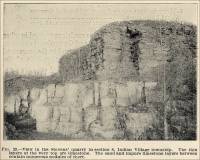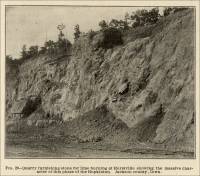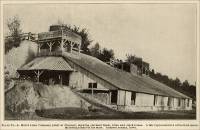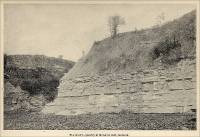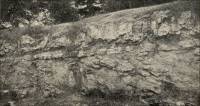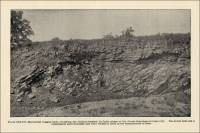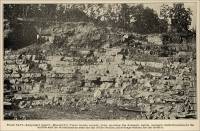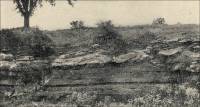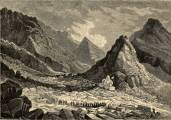
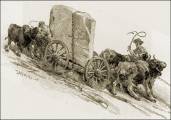

List of Quarries in Iowa
& Quarry Links,
Photographs and Articles
- Independence, Iowa - View in City Quarry at Independence showing effect of crushing in the Spirifer penatus beds, upper part of brecciated zone, Fig. 22 (From Iowa Geological Survey, Vol. XVII, Fifteenth Annual Report of the Iowa State Geologist, 1906.)
- Indian Village Township, Iowa - View in the Stevens' Quarry in Section 8, Indian Village township. The thin layers at the very top are limestone. The sand and impure limestone layers between contain numerous nodules of chert.
- Iowa – the What Cheer Stone Company (The following information
is from the “Notes From Quarry and Shop” section in Stone:
An Illustrated Magazine, Vol. XI, No. 6, November, 1895, Frank W. Hoyt,
Publisher, New York, pp. 574.)
"Incorporated – The What Cheer (Iowa) Stone Company. The capital stock is $20,000."
- Iowa City (near), Iowa - the Conklin Quarry (Limestone) & Fine Grind Limestone Plant - River Products Company, Inc. (present-day company, Quarry: 3259 Dubuque Street N.E., Iowa City, Iowa 52240, (319) 354.1090.
According to the “History of River Products Company, Inc.” section of this web site, the company opened the Conklin Quarry in 1920. The Conklin Quarry is located north of the Iowa River in Pennsylvania Township. “Geological surveys indicated a concentrated deposit of quality limestone. The stone tested high in calcium, a geological anomaly to this area.”
The company built a “fine grind limestone plant” at the Conklin Quarry in 1990. This plant produced dry sand and “a specification limestone product for use in coal burning, fluidized boiler bed furnaces.” In 1998 equipment was installed to expand the operations resulting in 9 products being produced at this plant “including both feed grade calcium for the livestock industry and poultry calcium grit for the poultry market.”
Access is not allowed at the quarry without prior approval. You can contact the company for further information about their quarries.
- Iowa City (northeast of), Iowa - the Ernst Quarry (AKA Dingleberry-Ernst Quarry) - River Products Company, Inc. (present-day company), Quarry: 2805 Wapsi Avenue N.E., Iowa City, Iowa 52240, 319.643.5115.
According to the “History of River Products Company, Inc.” section of this web site, the company began to develop the Dingleberry-Ernest Quarry site in 1999; start-up occurred in the fall of 2000. The quarry is located northeast of Iowa City, Johnson County, Iowa.
- Iowa City, Iowa - River Products Company, Inc. (present-day company), 3273 Dubuque Street N.E. P.O. Box 2120, Iowa City, Iowa 52244-2120, (319) 338.1184.
History of River Products Company, Inc.
According to the River Products Company, Inc. web site, this company was the first successful manufacturing operation in Iowa City. The Conklin limestone quarry opened in 1920; it is located north of the Iowa River in Pennsylvania Township.
The limestone taken from this quarry is used in road building, waterways, and agricultural use. Farmers use the agricultural lime “during the spring planting and fall harvest seasons” to reduce soil acidity and to nurture the soil to help it to remain productive.
Other quarries were acquired by the company in 1963 in Washington and Louisa Counties. The company began a crushing operation in 1982 at the Klein Quarry located west of Coralville, Johnson County, Iowa. A “fine grind limestone plant,” was built at the Conklin Quarry in 1990, and in 1998 equipment was added to expand the operations. Then in 1999 the company began to develop the Dingleberry-Ernst Quarry located northeast of Iowa City, Johnson County, Iowa; production started in the fall of 2000. About 1999 the company employed 86 full-time employees; and the company moved the corporate offices from downtown to 3273 Dubuque Street, N.E., in Iowa City, Iowa.
Access is not allowed at their quarries without specific approval. You can contact the company for further information about their quarries.
- Iowa Falls (near), Iowa - Marble Quarries. The following information is from The Monumental News, “Quarry Notes” section, August, 1895, Vol. 7, No. 8, Chicago, Illinois , pp. 504.
“The marble quarries in the vicinity of Iowa Falls, Ia., are being developed, but are not in shape yet for large orders, though some business is reported to have been done with the product.”
-
Jackson County, Iowa - Quarry furnishing stone for lime burning at Hurstville showing the massive character of this phase of the Hopkinton. Jackson county, Iowa.
- Jackson
County, Iowa - Hurstville
Lime Kilns (history and photograph) presented
by Jackson County Conservation.
The site presents a photograph of the lime kilns The kilns are located just north of Maquoketa. Building material was produced from these kilns and sent across the country.
- Jackson County,
Iowa - Hurstville Lime Kilns. The following quote is used with
permission and is extracted from A Guidebook to Mining In America: Volume
2: East (Minnesota, Iowa, Missouri, Arkansas, Louisiana, and farther
East), by John R. Park, Stonerose Publishing Co., Miami,
Florida, April, 2000," available at Stonerose
Publishing Company.
"Visitors may walk around the bases of the kilns, walk into the archways where the lime was extracted, and may peer into the fireboxes. The rock crusher is accessible via a stairway which also provides an overview. Exhibit boards with text and illustrations provide additional information.."
"...The four 30'-tall lime kilns were built in the 1870s by Alfred Hurst. The first kiln (no longer extant) was a small 'pot kiln' built in 1871 to test the quality of the lime that could be produced. The later four kilns are about 50' apart and are built into a limestone bluff. The introduction of Portland cement in 1914 reduced the demand for lime, and as a result, the crushed-rock operations were expanded. The kilns were closed in the 1930s, at which time, Hurstville became a ghost town.
"Mr. Park visited the Jackson County Historical Museum and found mention of another limeworks described as 'Pinhook Lime Kilns near Lakehurst Dam.'
- Jackson County,
Iowa - Hurstville Lime Kilns. The following quote is used with
permission and is extracted from A Guidebook to Mining In America: Volume
2: East (Minnesota, Iowa, Missouri, Arkansas, Louisiana, and farther
East), by John R. Park, Stonerose Publishing Co., Miami,
Florida, April, 2000," available at Stonerose
Publishing Company.
- Jackson County, Iowa - A. Hurst Lime Company plant at Pinhook, showing elevated track, kilns and stock house. A fair representative of the lime manufacturing plants of the state. Jackson County, Iowa.
- Johnson County, Iowa - State Quarry beds, State Quarry, Johnson County, Iowa.
- Johnson County, Iowa - Old State Quarry
Preserve (The quotation below is no longer available on this web site.) According to the Iowa Department of Natural Resources web site, mining limestone at the Old State Quarry Preserve occurred in the 1840s.
Limestone from these quarries was used for the Old State Capitol building in Iowa City and the foundation of the present capitol building in Des Moines. Hand-drilled holes can still be seen on the north face of the quarry.
<http://www.state.ia.us/parks/oldstate.htm>"Old State Quarry has historical and geological significance.It is composed mainly of cemented fossil fragments which were concentrated in a high energy tidal surge channel." During the 1830s a series of quarries were opened in the area. The Old State Quarry is one of these quarries, which provided building stone for the Old State Capitol building in Iowa City. The quarry also provided stone for the foundation of the present capitol building in Des Moines. "In the north face, hand-drilled holes can still be seen where spikes were driven to pry loose blocks of stone."
- Keokuk, Iowa - Section at Union Depot in Keokuk showing chert beds.
- Keokuk, Iowa - Quarry at McGavic mill, Keokuk.
- Keokuk County, Iowa - Local unconformity in Verdi beds, near Showman station, Keokuk County, Iowa.
- Lacey-Keosauqua
State Park: Iowa's “Big Bend” Country, by Robert M.
McKay (Adapted from Iowa Geology 1997, Iowa Department of
Natural Resources.) (The following quote is used with the permission
of the Iowa Geological Survey Bureau.) (This site includes several very
nice photographs of the quarry, bridge and a building built of the limestone,
and a map of the area.)
"Two distinct types of stone were used, the brown dolomite of the St. Louis Formation, taken from quarries west of the park along Chequest Creek, and the younger light-gray limestone of the Pella Formation quarried within the park from ledges exposed along Wesley Creek. The picnic shelters and park residence are built of the brown dolomite, while the bridges, stone lodge and lake bath house are constructed from the lighter-colored gray limestone. This light-gray to white, fine-grained limestone is the product of a clear-water shallow sea, and is well-suited to dimensioning for building stone. The limestone was extracted from several Keosauqua area quarries during the 1800's and early 1900's. The historic CCC quarry along Wesley Creek within the park, while somewhat overgrown, is still accessible by foot, and while walking along the sun-drenched quarry ledges examining the air-drilled holes, one can easily imagine industrious crews of young men landing their sledges on the splitting pins."
- LeClaire (near), Scott County, Iowa - General view of LeClaire Stone Company Quarry, near LeClaire, Scott County, Iowa. The handling of material is done by derricks alone.
- Letts, Iowa - J. H. Collins (from Design Hints For Memorial Craftsmen, May 1930, Vol. 6, No. 11, pp. 27)
J. H. Collins was listed as one of the customers of the Mount Brothers of Memphis Missouri, who sold their Air Take-off Device used in carving cemetery stones.
- Lime City, Cedar County, Iowa – Gower Limestone at Lime City (The photograph below is from Iowa Geological Survey Volume XVIII, Annual Report, 1906, Samuel Calvin, Ph.D., State Geologist, James H. Lees, Assistant State Geologist, Des Moines: Published for Iowa Geological Survey, 1907, pp. 249.)
- Lime City, Cedar County, Iowa - Limestone Quarries. Today
all that is left of Lime City, located about 6 miles north/northwest of
Wilton, are three lime kilns and the limestone quarries. (The link
from which the preceding information was obtained is no longer available.)
<http://www.iowa-counties.com/cedar/limecity.htm>
- Lime City, Cedar County, Iowa - Lime City, Iowa, Lime Industry by Megan Moeller. This is an account of the Lime City area lime industry and includes a bibliography
- Lowden, Iowa – Lowden Quarry, 2080 160th Street, Lowden, Iowa, (563) 944-5401, an Aggregate Quarry of Wendling Quarries, Inc. (present-day company) (This link is no longer available, although you can view the map on the Internet Archive Wayback Machine.)
<http://www.wendlingquarries.com/locations/index.html> - Maquoketa, Iowa – Iron Hill Quarry, 1518 145th Avenue, Maquoketa, Iowa, (563) 652-6025, an Aggregate Quarry of Wendling Quarries, Inc. (present-day company) (This link is no longer available, although you can view the map on the Internet Archive Wayback Machine.)
<http://www.wendlingquarries.com/locations/index.html> - Maquoketa, Iowa – Joinerville Quarry, 3839 123rd Avenue, Maquoketa, Iowa, (563) 673-3581, an Aggregate Quarry of Wendling Quarries, Inc. (present-day company) (This link is no longer available, although you can view the map on the Internet Archive Wayback Machine.)
<http://www.wendlingquarries.com/locations/index.html> - Maquoketa, Iowa – Maquoketa Quarry, 19765 Rockdale Road, Maquoketa, Iowa, (563) 652-2221, an Aggregate Quarry of Wendling Quarries, Inc. (present-day company) (This link is no longer available, although you can view the map on the Internet Archive Wayback Machine.)
<http://www.wendlingquarries.com/locations/index.html> - Marble Rock, Floyd County, Iowa – Old lime Quarry above Marble Rock, Floyd County, Iowa showing Stromatopora zone and brecciated zone.
- Marble Rock, Floyd County, Iowa - Marble Rock Quarry showing evenly bedded, lithographic beds below, and Stromatopora and becciated zone above.
- Marshalltown, Iowa - Le Grand Quarry Co. (Marble Dealer) (The
following information is from an advertisement in Stone: An Illustrated
Magazine, Vol. XI, No.. 6, November, 1895, Stone Publishing Co., New
York, pp. XLiv.)
Le Grand Qurry Co.
Marshalltown, Ia.Iowa Marble, Iowa Caenstone,
Fossilite Marble, Oolitic Limestone. - Marshall County, Iowa - Typical section in quarry of LeGrand Quarry Company, Quarry, Marshall county, Iowa.
- Mason City, Cerro Gordo County, Iowa - Kuppinger Quarry, Mason City, Cerro Gordon County, Iowa, showing the dolomite below, compact white limestone in the middle and the Stromatopora near the top of the section; an average section for the district.
- McGregor, Clayton County, Iowa - Quarry in Lower Buff beds at McGregor. Thin-bedded limestone is seen at top. Fig. 9 (From Iowa Geological Survey, Vol. XVII, Fifteenth Annual Report of the Iowa State Geologist, 1906.)
- Montour, Iowa – Montour Quarry, 2920 C Avenue, Montour, Iowa, (641) 492-6115, an Aggregate Quarry of Wendling Quarries, Inc. (present-day company) (This link is no longer available, although you can view the map on the Internet Archive Wayback Machine.)
<http://www.wendlingquarries.com/locations/index.html> - Moscow, Iowa – Moscow Quarry, 1148 Nobel Avenue, Moscow, Iowa, (563) 724-3393, an Aggregate Quarry of Wendling Quarries, Inc. (present-day company) (This link is no longer available, although you can view the map on the Internet Archive Wayback Machine.)
<http://www.wendlingquarries.com/locations/index.html> - Mt. Pleasant, Iowa - Principal quarry section southwest of Mt. Pleasant, Iowa.
- Muscatine, Iowa - Gruber Marble Works. The following information is from The Monumental News, “Trades Notes” section, August, 1895, Vol. 7, No. 8, Chicago, Illinois , pp. 502.
“Geo. J. Gruber of the Gruber Marble works at Muscatine, Ia., has recently secured his third order for monumental work from ex-governor Boies. The last order is for a monument to be erected at Waterloo , in memory of the governors daughter recently deceased.”
Commercial use of material within this site is strictly prohibited. It is not to be captured, reworked, and placed inside another web site ©. All rights reserved. Peggy B. and George (Pat) Perazzo.

